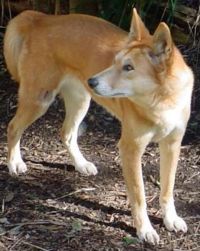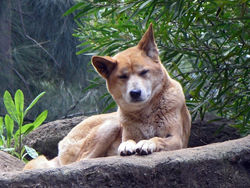Dingo
2007 Schools Wikipedia Selection. Related subjects: Mammals
| iDingo | ||||||||||||||||
|---|---|---|---|---|---|---|---|---|---|---|---|---|---|---|---|---|
 |
||||||||||||||||
|
|
||||||||||||||||
| Scientific classification | ||||||||||||||||
|
||||||||||||||||
|
|
||||||||||||||||
| Canis lupus dingo ( Meyer, 1793) |
| Breed classification | ||||
|---|---|---|---|---|
|
||||
| Breed standards (external link) | ||||
| ANKC |
The dingo (plural dingoes or dingos), Canis lupus dingo, is a type of wild dog, probably descended from the Indian Wolf (Canis lupus pallipes). It is commonly described as an Australian wild dog, but is not restricted to Australia, nor did it originate there. Modern dingoes are found throughout Southeast Asia, mostly in small pockets of remaining natural forest, and in mainland Australia, particularly in the north. They have features in common with both wolves and modern dogs, and are regarded as more or less unchanged descendants of an early ancestor of modern dogs. The name dingo comes from the language of the Eora Aboriginal people, who were the original inhabitants of the Sydney area. Another name for the dingo is warrigal.
Characteristics
At between 10 and 24 kilograms, dingoes are a little smaller than wolves of the northern hemisphere (in keeping with Bergmann's Rule) and have a lean, athletic build. They stand between 44 and 63 cm high at the shoulder, and the head-body length varies between 86 and 122 cm. Colour varies but is usually ginger: some have a reddish tinge, others are more sandy yellow, and some are even black; the underside is lighter. Alpine dingoes are found in high elevation areas of the Australian Alps, and grow a second thicker coat during late autumn for warmth which usually sheds by mid to late spring. Most dingoes have white markings on the chest, feet, and the tip of the tail; some have a blackish muzzle. They can live for up to 14 years in captivity, but have a more usual lifespan of 3-7 years.
Unlike the domestic dog, dingoes breed only once a year, generally do not bark, and have erect ears. They have a more independent temperament than domestic dogs, and the skull is distinctive, with a narrower muzzle, larger auditory bullae, larger canine teeth, and a domed head. They are extremely agile and are known to climb trees.
Wild dingoes prey on a variety of animals, mostly small or medium-sized, but also larger herbivores at need. They are opportunistic carnivores, taking prey ranging in size from lizards and small rodents up to sheep and kangaroos.
Dingoes do not generally form packs; they more often travel in pairs or small family groups. However, they are capable of forming larger packs to hunt cooperatively. While dingo groups use defined home territories, these territories can overlap with those of other groups.
Domestication is possible only if the dingoes are taken into captivity as young pups.
Origin
Earliest evidence
The earliest known dingo skulls have been found in Vietnam and are about 5,500 years old. Dingo remains from 5,000 to 2,500 years old have been found in other parts of South-east Asia, and the earliest fossil record of dingoes in Australia is 3,500 years old. Very dingo-like bones have also been found in Israel and the West Bank dating 14,000 years old.
The ultimate origin of the dingo is uncertain, but it is possibly related to the wolves of south-west Asia, and probably arose in that area at about the same time as humans began to develop agriculture.
Modern dogs are believed to be the result of artificial selection of various traits from a single domestication of the grey wolf about 15,000 years ago: the modern dingo appears to be a relatively pure-bred descendant of one of the earliest domestications.
It is probable that 14,000 year-old dingo-like bones found in Israel, and 9,000 year-old bones in the Americas are evidence of the commensal relationships that developed between wolves and people—as people migrated eastward, semi-domesticated dogs came with them. The Carolina Dog, often dubbed "American Dingo", shows anatomical and comportmental similarities with the dingo, and potential genetic links are being investigated at the University of South Carolina.
Introduction to Australia
Dingoes did not arrive in Australia as companions of the Aborigines around 50,000 years ago, but were probably brought by Austronesian traders much later. A study of dingo mitochondrial DNA published in 2004 places their arrival at around 3000 BC, and suggests that only one small group may be the ancestors of all modern Australian dingoes.
The dingo spread rapidly across Australia, probably with human assistance, and is thought to have occupied the entire continent within a short time. The full extent of the ecological change brought about by the introduction of the dingo remains unknown, but the dingo has been suspected to be the cause of a series of extinctions, notably of marsupial carnivores, including the last remaining large predator, the Thylacine, though this particular extinction is in doubt. It is thought that the co-operative pack behaviour of dingoes gave them an important competitive advantage over the more solitary marsupial carnivores, particularly during Australia's frequent droughts (when game becomes scarce).
Relationship with humans
Aboriginal people across the continent adopted the dingo as a companion animal, using it to assist with hunting and for warmth on cold nights. (The terms "two-dog night" and "three-dog night" are believed to come from Aboriginal idiom, describing the overnight temperature.)
When European settlers first arrived in Australia, dingoes were tolerated, even welcomed at times. That changed rapidly when sheep became an important part of the white economy. Dingoes were trapped, shot on sight, and poisoned—often regardless of whether they were truly wild or belonged to Aboriginal people. In the 1880s, construction of the great Dingo Fence began. The Dingo Fence was designed to keep dingoes out of the relatively fertile south-east part of the continent (where they had largely been exterminated) and protect the sheep flocks of southern Queensland. It would eventually stretch 8500 kilometres; from near Toowoomba through thousands of miles of arid country to the Great Australian Bight and be (at that time) the longest man-made structure in the world. It was only partly successful: dingoes can still be found in parts of the southern states to this day, and although the fence helped reduce losses of sheep to predators, this was counterbalanced by increased pasture competition from rabbits and kangaroos.
Dingoes have received bad publicity in recent years as a result of the highly publicised Azaria Chamberlain disappearance and also because of dingo attacks on Fraser Island in Queensland. In 2001 around 200 dingoes lived on the island, and 20 people were attacked in the preceding six years. In April 2001 a nine-year-old child was killed in one such attack near Waddy Point on Fraser Island. This led to a cull of the animals which were actually protected by law. The owners of the island, the Ngulungbara people, fought the cull through a legal injunction. In all, 65 dingoes were eventually destroyed. In 2004 more legal battles began after a dingo entered a bedroom in Kingfisher Bay resort where two young children were present. More recently in September 2006 a dingo was shot dead by Parks and Wildlife rangers after attacking a four-year-old child who had been playing in shallow water near Eurong on the island.
The laws concerning keeping dingoes as pets is inconsistent from one state to another in Australia. It is recommended that if dingoes are to be pets, that they be adopted at a young age in order to help them bond with humans. However, dingoes are wild dogs and have strong hunting instincts. They may kill birds and small animals, and get into tangles with raccoons. When hunting larger animals, dingoes hassle or annoy their prey until the prey is off balance or tired, and the dingoes can attack.; they will do the same thing when playing or interacting with other domestic dogs - domestic dogs misunderstand this behaviour, resulting in dog fights and the appearance of the dingo as the agressive animal. Like other hunting dogs, dingoes need to be heavily worked in order to be happy and they need space to run. Dingoes cannot be trusted off leash and they will not enjoy sitting at home on the couch all day. In sum, as a result of this wild hunter instinct and a high intelligence, dingoes do not make good domestic pets.
Potential extinction
As a result of interbreeding with dogs introduced by European settlers, the purebred dingo gene pool is being swamped. By the early 1990s, about a third of all wild dingoes in the south-east of the continent were dingo/domestic dog crosses, and although the process of interbreeding is less advanced in more remote areas, the extinction of the subspecies in the wild is considered inevitable.
Although protection within Federal National Parks, World Heritage areas, Aboriginal reserves, and the Australian Capital Territory is available for dingoes, they are at the same time classified as a pest in other areas. Since a lack of country-wide protection means they may be trapped or poisoned in many areas, in conjunction with the hybridisation with domestic dogs the taxon was assessed as 'Vulnerable' in 2004.



